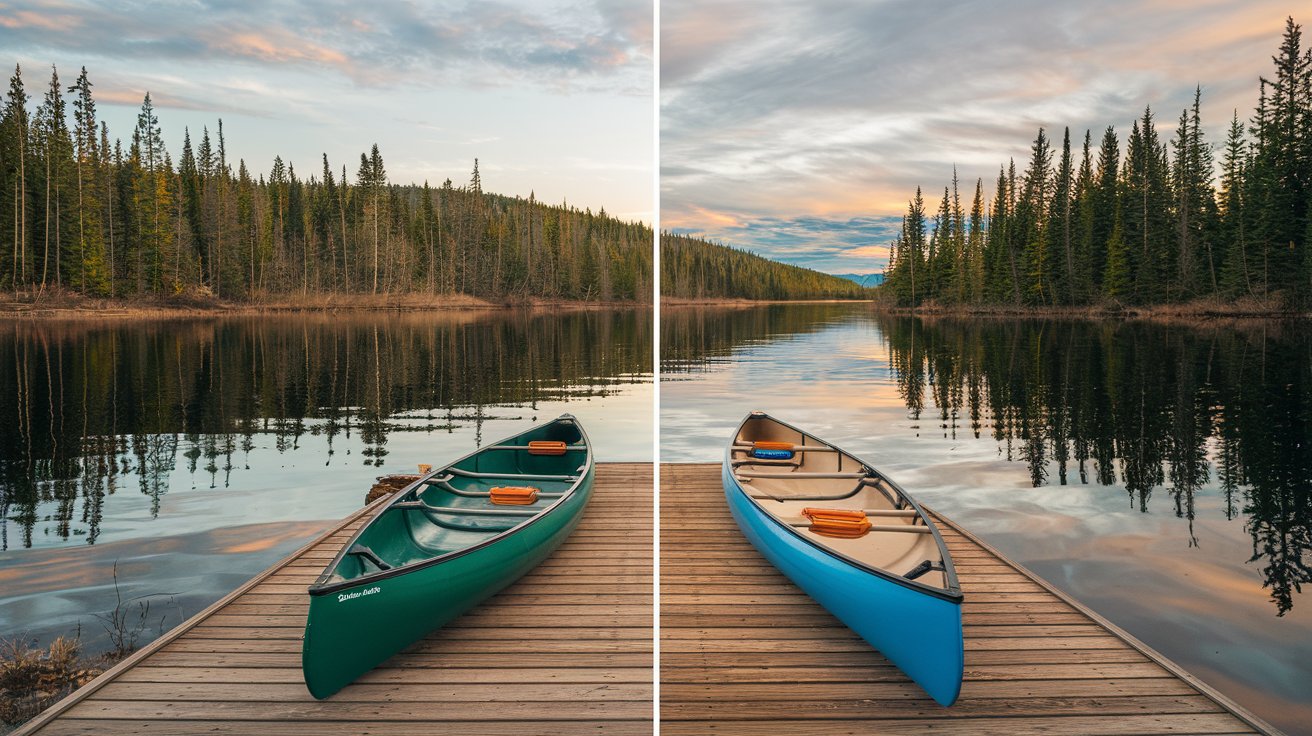When it comes to choosing between a plastic vs fiberglass canoe, paddlers are often faced with a variety of options, each boasting unique features and benefits. Whether you’re a seasoned kayaker or a first-time canoe enthusiast, understanding the differences between these two popular materials is crucial for selecting the right canoe material for your adventures.
Both plastic canoes and fiberglass boats have their own set of advantages and drawbacks, making the decision largely dependent on your specific needs, budget, and intended use. In this comprehensive guide, we’ll delve into the nuances of plastic and fiberglass canoes, helping you determine which option aligns best with your outdoor aspirations.
Which is Better Plastic vs Fiberglass Canoe
| Feature | Plastic Canoes | Fiberglass Canoes |
|---|---|---|
| Weight | Heavier (50-80 lbs) | Lighter (35-65 lbs) |
| Durability | High impact resistance, very durable | Less impact resistant, more prone to cracks |
| Cost | More affordable ($500-$1,500) | More expensive ($1,000-$3,000+) |
| Maintenance | Low maintenance, easy to repair | Higher maintenance, repairs can be complex |
| Performance | Good stability, slower | Excellent glide, faster |
| Maneuverability | Less responsive | More responsive, better control |
| UV Resistance | Good (with UV-resistant plastics) | Fair (may need UV-protective coating) |
| Aesthetics | Basic, limited color options | Sleek, customizable designs |
| Longevity | 10-20 years with proper care | 10-15 years, may require more upkeep |
| Best Use | Recreational, whitewater, beginners | Touring, racing, experienced paddlers |
Deciding whether a plastic vs fiberglass canoe is better hinges on several factors, including durability, weight, maintenance, and cost. Plastic canoes are renowned for their incredible durability and impact resistance, making them an excellent choice for beginners and those who plan to use their canoe in rugged environments like whitewater. Additionally, plastic boats are generally cheaper than their fiberglass counterparts, offering an affordable option without compromising functionality.
On the other hand, fiberglass canoes are prized for their glide and stiffer hulls, which enhance performance, especially during long multi-day trips or competitive kayaking. Fiberglass materials are lighter than aluminum, providing a balance between weight and strength that appeals to experienced paddlers seeking a more responsive ride.
However, fiberglass canoes require more meticulous maintenance and repairs, which can be a downside for those looking for a low-maintenance option. Ultimately, the choice between plastic vs fiberglass depends on your priorities—whether you value durability and cost-effectiveness or performance and sleek maneuverability.
Plastic Types used to Build a Canoe
The construction of plastic canoes involves various types of plastics, each contributing to the boat’s overall performance and durability. The most common materials include polyethylene, royalex, and thermoformed plastic.
- Polyethylene is the most widely used due to its incredibly durable nature and high impact resistance, making plastic kayaks and canoes crafted from this material highly resilient to dents and abrasions.
- Royalex, a proprietary material known for its stiffness and flexibility, offers enhanced durability and a longer lifespan compared to standard polyethylene. It features layers of plastic and rubber, providing excellent resistance to chipping and cracking, which is particularly beneficial for whitewater canoes where the risk of impact damage is higher.
- Thermoformed plastic is another option, often used in higher-end models, as it allows for more intricate designs and improved hull shapes that enhance the canoe’s glide and performance on the water.
Manufacturers like Grumman and Old Town utilize these plastic types to create plastic and composite canoes that cater to a wide range of paddling styles.
Whether you’re looking for a robust plastic canoe for rugged terrains or a sleek model for leisurely paddling, understanding the different plastic types can help you make an informed decision when looking to buy your next canoe.
How Long do Plastic Canoes Last?
One of the primary advantages of choosing a plastic canoe is its longevity. Plastic boats are known for their incredible durability, often lasting many years with proper care. The lifespan of a plastic canoe can range from 10 to 20 years, depending on factors such as usage frequency, maintenance routines, and environmental conditions. Thermoformed plastic canoes, for example, tend to have a longer lifespan compared to older polyethylene models due to advancements in manufacturing processes and material quality.
Exposure to harsh sunlight can hot in the sun and potentially degrade the plastic over time, but modern plastics are often UV-resistant, minimizing this risk. Regular cleaning and storage in a shaded or indoor area during the end of the season can significantly extend the life of your canoe.
Additionally, plastic canoes are easy to repair, allowing for minor dents or abrasions to be fixed without professional assistance, further enhancing their longevity.In contrast, fiberglass canoes may require more intensive maintenance to ensure their durability over time. While both materials offer impressive lifespans, the plastic option is generally more resilient against everyday wear and tear, making it a great choice for paddlers seeking a low-maintenance and long-lasting canoe.
Pros and Cons of Plastic Canoe
Pros of Plastic Canoes
Plastic canoes offer several advantages that make them a popular choice among both novice and experienced paddlers. Their incredible durability and high impact resistance ensure that they can withstand rough handling, collisions, and exposure to various elements without sustaining significant damage. This makes plastic boats ideal for rugged environments and frequent use.
Additionally, plastic canoes are typically more affordable than fiberglass models, allowing paddlers to invest in a reliable canoe without breaking the bank. The ease of repair is another significant benefit, as minor dents or scratches can be easily fixed with basic tools and materials.
Plastic canoes are also heavier than aluminum but offer better stability, which is advantageous for beginners or those carrying heavy gear.
Cons of Plastic Canoes
Despite their many benefits, plastic canoes do come with some drawbacks. Their heavier weight can make them more challenging to portage and transport, especially for solo paddlers.
While they are durable, plastic canoes can still suffer from wear and tear over time, particularly if not properly maintained or stored away from prolonged exposure to sunlight, which can cause the material to become brittle and deform. Moreover, plastic canoes often lack the sleek glide and performance characteristics of fiberglass and composite canoes.
This can be a disadvantage for paddlers seeking a more responsive and faster boat for activities like competitive kayaking or long-distance trips. Lastly, while repairs are relatively easy, significant damage may require replacing parts or the entire hull, which can be costly in the long run.
Pros and Cons of Fiberglass Canoe
Pros of Fiberglass Canoes
Fiberglass canoes are celebrated for their superior performance and lightweight characteristics. The fiberglass hulls provide a smooth and efficient glide through the water, making them highly desirable for paddlers who enjoy speed and maneuverability.
Fiberglass boats are lighter than aluminum, which enhances portability and ease of handling during long treks or multi-day excursions.Another significant advantage is the aesthetic appeal of fiberglass canoes. With sleek designs and customizable options, they often appear more refined and attractive compared to their plastic counterparts. The stiffer hulls contribute to better control and responsiveness, allowing paddlers to navigate challenging waters with greater precision.
Additionally, fiberglass canoes can be outfitted with various accessories and modifications, making them versatile for different types of paddling activities, including whitewater canoeing.
Cons of Fiberglass Canoes
Despite their numerous benefits, fiberglass canoes also have certain disadvantages. The primary drawback is the higher cost associated with their construction and maintenance. Fiberglass materials are more expensive, making fiberglass canoes a significant investment compared to plastic models. Furthermore, repairs to fiberglass canoes are generally more complex and may require professional assistance, especially if the hull is compromised.
Fiberglass canoes can also be less impact resistant than plastic canoes, making them more susceptible to damage from hits, scrapes, or abrasions. Exposure to extreme conditions, such as UV rays and temperature fluctuations, can weaken the hull over time, necessitating regular upkeep to maintain their integrity and appearance.
Additionally, fiberglass canoes may not be as durable in rugged environments where constant contact with rocks and debris is common, potentially leading to costly repairs and a shorter overall lifespan compared to their plastic counterparts.
Best Material to Build a Canoe
Selecting the best material to build a canoe involves weighing the pros and cons of each option against your specific needs and preferences. Plastic and fiberglass are both excellent choices, each offering distinct advantages.
Polyethylene plastic is ideal for those prioritizing durability, affordability, and minimal maintenance, making it perfect for recreational paddlers and those venturing into rougher waters like whitewater.
Conversely, fiberglass canoes are the right choice for paddlers who value performance, speed, and a lightweight design. They are particularly well-suited for kayakers who participate in competitive events or undertake extensive multi-day trips.
Additionally, composite canoes, which incorporate materials like Kevlar or Royalex, offer a balance of strength, lightness, and flexibility, catering to advanced paddlers seeking a stiffer hull and enhanced handling.Ultimately, the best material depends on your intended use, budget, and maintenance willingness.
For those who want a canoe that can withstand heavy use with minimal care, plastic canoes are a superb option. Meanwhile, paddlers looking for superior performance and are prepared to invest in maintenance may find fiberglass canoes or other composite options more appealing.
Maintaining Plastic and Firber glass Canoes
Plastic Canoes Maintenance
- Cleaning:
- Rinse with fresh water after each use
- Use mild soap and soft brush to remove dirt and grime
- Avoid harsh chemicals that can degrade the plastic
- UV Protection:
- Apply UV-resistant spray annually
- Store out of direct sunlight when not in use
- Repair:
- Small scratches can be buffed out with sandpaper
- Deeper gouges can be filled with plastic welding rods
- Large cracks may require professional repair
- Storage:
- Store upside down on padded supports
- Keep away from heat sources to prevent warping
- Inspection:
- Check for wear on keel and gunwales regularly
- Look for signs of oil canning (hull deformation)
Fiberglass Canoes Maintenance
- Cleaning:
- Wash with fresh water after each use
- Use specialized boat soap for thorough cleaning
- Wax the hull 1-2 times per year for protection
- Gelcoat Care:
- Apply UV-protective marine polish annually
- Buff out minor scratches with rubbing compound
- Repair:
- Small cracks can be fixed with epoxy resin
- Larger damages may require professional fiberglass repair
- Storage:
- Store indoors or under a breathable cover
- Support the hull evenly to prevent stress points
- Inspection:
- Check for signs of delamination or bubbling in the gelcoat
- Examine for hairline cracks, especially around fittings
General Maintenance Tips for Both Types:
- Always drain water after use and dry thoroughly
- Inspect and maintain hardware (seats, thwarts, etc.) regularly
- Address any damage promptly to prevent further deterioration
- Consider professional servicing for major repairs or refurbishment
By following these maintenance guidelines, owners of both plastic and fiberglass canoes can significantly extend the life of their vessels and ensure optimal performance on the water. Remember, consistent care is key to preserving your canoe’s condition and value over time.

